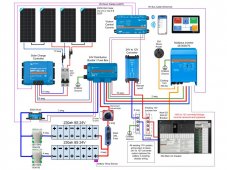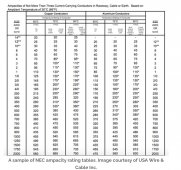Really think your battery wires are too small. 3000 volt amp inverter is actually 2400 continuous. If these batteries are run to a low SOC, the voltage will drop to as low as possibly 10 volts. THat’s 240 amps, plus another 15% for inverter losses for a around 276 amps. Wiring inverters for me has been more about ampacity than voltage loss.
So, I am planning on wiring my similarly sized inverter at 2 AWG for battery interconnect wire and 4 AWG after the batteries are combined to the inverter.
View attachment 69975
Also recommend the much bigger much more expensive with a higher AIC rated Class T fuse. If operating at lower ends of SOC, you could also easily exceed 200 amps.
I have VIctron equipment and for the Disribution / fuse box, I went with busbars and fuses. The central com is not necessary, unless the Multiplus requires it, but looks like this provides quite a bit of information.
The converter you list should work with the wire you listed provided ampacity is not an issue. I have the 70 amp VIctron converter which requires thicker than the 6 AWG you list





